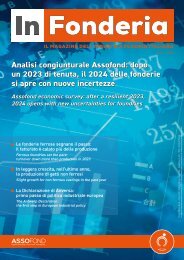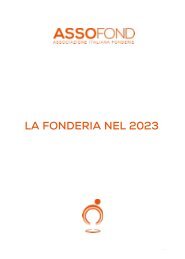In Fonderia 2 2024
Secondo numero del 2024 di In Fonderia
Secondo numero del 2024 di In Fonderia
Create successful ePaper yourself
Turn your PDF publications into a flip-book with our unique Google optimized e-Paper software.
IN PRIMO PIANO<br />
fiuto. Senza un utilizzo certo il residuo non potrà<br />
essere classificato come sottoprodotto, in<br />
quanto non potrà soddisfare tutti e quattro i<br />
requisiti richiesti dalla normativa, e diventerà<br />
così un rifiuto. Di fatto, la mancanza di una destinazione<br />
finale è però una criticità anche nel<br />
caso in cui il residuo gestito come rifiuto venga<br />
recuperato senza un destino certo: in tale<br />
circostanza, infatti, il rifiuto perderà di appetibilità<br />
economica per gli stessi impianti di recupero,<br />
in quanto non potrebbero vendere il<br />
bene recuperato, finendo per dover stoccare<br />
il materiale per un periodo di tempo indeterminato<br />
e rischiando così di doversi assumere i<br />
relativi costi di gestione. L’alternativa sarebbe<br />
l’invio in discarica, i cui costi di smaltimento,<br />
naturalmente maggiori di quelli del recupero,<br />
andrebbero però successivamente a ricadere<br />
sulle fonderie stesse.<br />
Le attività di Assofond in questo ambito sono<br />
da tempo concentrate ad abbattere le cosiddette<br />
“barriere non tecnologiche” presenti<br />
nella gestione dei residui, sia agendo a livello<br />
istituzionale, come fatto ad esempio con<br />
la pubblicazione delle linee guida di Regione<br />
Lombardia per la gestione delle terre esauste<br />
di fonderia – che, dati i contenuti tecnici,<br />
possono essere utilizzate su tutto il territorio<br />
nazionale – sia cercando di individuare o di<br />
creare nuove filiere di simbiosi industriale, cercando<br />
sul mercato vie di utilizzo per tali materiali.<br />
A questo proposito, l’associazione ha<br />
recentemente individuato la possibilità di un<br />
utilizzo delle terre esauste, classificate come<br />
sottoprodotto o End of Waste, per la riqualificazione<br />
ambientale di una cava sita nel comune<br />
di Casei Gerola (PV).<br />
CONCLUSIONI<br />
Le ragioni che, relativamente ai residui di fonderia,<br />
possono rendere difficile la chiusura del<br />
cerchio per la realizzazione dell’economia circolare,<br />
al momento sono molteplici. Quelle più<br />
critiche, tuttavia, sono ricomprese all’interno<br />
nel novero delle barriere non tecnologiche.<br />
La complessità dei procedimenti amministrativi<br />
per il rilascio delle autorizzazioni al trattamento<br />
dei rifiuti, le lacune normative e la loro<br />
differente applicazione all’interno del territorio<br />
nazionale causano incertezza e timore in tutti<br />
gli attori coinvolti, siano essi imprenditori o enti<br />
di controllo. Sebbene spesso da più parti si affermi<br />
la necessità di una semplificazione amer<br />
as End of Waste, the main obstacle to closing<br />
the circle is the identification of a certain<br />
destination: the possible lack of this has effects<br />
on its management as a by-product or as<br />
waste. Without a definite use, the residue cannot<br />
be classified as a by-product, insofar as<br />
it cannot meet all four legal requirements and<br />
thus becomes waste. <strong>In</strong> fact, the lack of a final<br />
destination is a critical issue even when the<br />
residue managed as waste is recovered with<br />
no specific purpose. <strong>In</strong> this case, the waste loses<br />
its economic appeal for the recovery plants<br />
themselves, insofar as they would not be able<br />
to sell the recovered goods and end up having<br />
to store the material for an indefinite period<br />
of time, thus risking having to bear the related<br />
management costs. The alternative would be<br />
the landfill, whose disposal costs, higher than<br />
recovery costs, would then fall on the foundries<br />
themselves.<br />
Assofond’s activities in this field have been<br />
focused for some time on breaking down the<br />
so-called “non technological barriers” in residue<br />
management, by acting on an institutional<br />
level, e.g. with the publication of guidelines<br />
for the Region of Lombardy for managing<br />
spent foundry sands – which, given their technical<br />
content, can be used nationwide – and<br />
by trying to identify or create new industrial<br />
symbiosis chains, searching for uses for such<br />
materials on the market. <strong>In</strong> this regard, the association<br />
has recently identified the chance to<br />
use spent sands, classified as a by-product or<br />
End of Waste, for the environmental redevelopment<br />
of a quarry situated in the municipality<br />
of Casei Gerola (PV).<br />
CONCLUSIONS<br />
The reasons that may make it difficult to close<br />
the circle to achieve the circular economy,<br />
with regard to foundry residues, are currently<br />
many. The most critical ones, however, are included<br />
in the group of non technological barriers.<br />
The complex administrative procedures for issuing<br />
permits to treat waste, the lack of regulations<br />
and their different application nationwide<br />
cause uncertainty and worry among all<br />
the players involved, be they entrepreneurs<br />
or supervisory bodies. While the need for simplification<br />
is often asserted on many sides,<br />
sometimes the difficulties are also due to a<br />
considerable resistance by the system to the<br />
30<br />
<strong>In</strong> <strong>Fonderia</strong>














